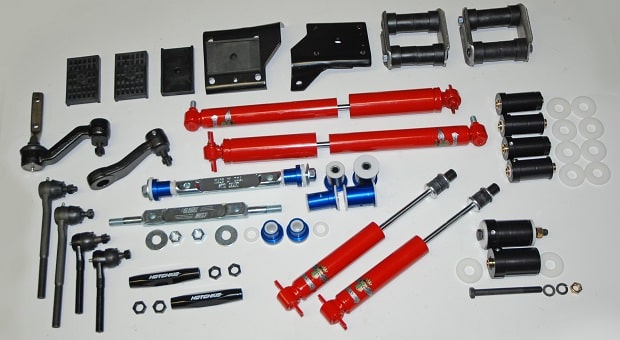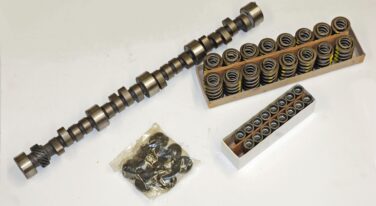
How to Improve Handling in Your Chevy Camaro or Nova Part 4
Over the past few issues, we’ve laid out a suspension and steering action plan for first generation Camaros, along with Novas circa 1968-74 (the ideas also apply to later leaf spring Camaros, Firebirds, Novas and similar cars). We’ve looked at upper and lower control arm bushings, control arm cross shafts and shock absorbers. With this issue, we’ll dig into ball joints, tie rod ends and other steering bits. The Classic Industries group (18460 Gothard Street, Huntington Beach, CA 92648; PH: 800-854-1280; Website: www.classicindustries.com) has some great insight into how to put together a package that flat works, but doesn't kill your bank account! More below:
First up are ball joints. Some ball joints are available with longer than stock pin length with the idea of correcting roll centers. Ball joints with hardened pins and stock type housings such as this are not rebuildable. Fair enough. But what is the advantage?
Camaros and Novas suffer from having a short spindle. This prevents the tire from cambering properly when powering through a corner; the top of the tire cambers out for too long before it starts pulling in. In turn, this causes the tire to scrub on the outside instead of running on the complete tire contact patch.
Tall ball joints add spindle height by increasing the distance between the two pivot points. Essentially, they’re a quick way to get ½-inch or so additional spindle height. Taller upper ball joints have no effect upon the ride height of the car; the upper arms are not weight bearing.
On the other hand, a taller spindle has a higher overall height than a factory spindle. This is because the upper ball joint pickup points are relocated in order to achieve better front-end geometry. The taller spindle height improves handling by modifying the camber curve. The end result is a negative camber gain during suspension compression when carving a corner. Some aftermarket spindles (for example, a Belltech) are simply lowered – they’re not taller. You can find taller than stock spindles without any drop or you can get a spindle that is both dropped and tall.
For our purposes, we decided to keep the ball joints and the spindles stock. Classic Industries offers a complete range of high quality replacement upper and lower ball joints for Camaros and Novas. They even have replacement boots for both the uppers and the lowers (conventional or urethane).
For tie rod ends, source new inners and outers; they too are readily available from Classic Industries). To join them, Classic Industries suggested solid tie rod sleeves from the folks at Hotchkiss. The setup from Hotchkiss includes machined hex bodies (so you can easily turn them to adjust toe with a basic open-end wrench) and matching jam nuts. They’re powder coated gloss black too. Installation for the tie rod ends and the Hotchkiss tie rod sleeves are exactly the same as stock too. See the photos for a better look.
Something else the folks from Classic Industries suggested was to consider the replacement of the idler arm and, in high mileage applications, the pitman arm as well. The reason is, these are wear items and if you don't address them, you could be chasing a not-so-tight steering issue. The idler arm is easy to replace (a couple of bolts) while the pitman arm will require a special puller. Classic Industries offers high quality replacement idler arms and a range of pitman arms too. Keep in mind, power steering pitman arms and manual steering pitman arms are different.
The final thing you should consider in the front end rehab are fasteners. New hardware isn’t expensive and you have to remember, these cars are in the 50-year-old range. For our purposes, Classic suggested we replace the upper and lower control arm studs, bolts and nuts. Ditto with other small hardware bits as well as complete rear end/spring installation hardware. The parts are readily available and since you already have the major components out, this is the time to swap the fasteners. By the way, the fasteners Classic Industries offers are exactly the same as original. They’re high quality and they fit. See the accompanying photos for more info on hardware.
Next time around, we’ll wrap up our series with some very interesting information on leaf spring bushings. You might be surprised at what you read. Watch for it!
First up are ball joints. Some ball joints are available with longer than stock pin length with the idea of correcting roll centers. Ball joints with hardened pins and stock type housings such as this are not rebuildable. Fair enough. But what is the advantage?
Camaros and Novas suffer from having a short spindle. This prevents the tire from cambering properly when powering through a corner; the top of the tire cambers out for too long before it starts pulling in. In turn, this causes the tire to scrub on the outside instead of running on the complete tire contact patch.
Tall ball joints add spindle height by increasing the distance between the two pivot points. Essentially, they’re a quick way to get ½-inch or so additional spindle height. Taller upper ball joints have no effect upon the ride height of the car; the upper arms are not weight bearing.
On the other hand, a taller spindle has a higher overall height than a factory spindle. This is because the upper ball joint pickup points are relocated in order to achieve better front-end geometry. The taller spindle height improves handling by modifying the camber curve. The end result is a negative camber gain during suspension compression when carving a corner. Some aftermarket spindles (for example, a Belltech) are simply lowered – they’re not taller. You can find taller than stock spindles without any drop or you can get a spindle that is both dropped and tall.
For our purposes, we decided to keep the ball joints and the spindles stock. Classic Industries offers a complete range of high quality replacement upper and lower ball joints for Camaros and Novas. They even have replacement boots for both the uppers and the lowers (conventional or urethane).
For tie rod ends, source new inners and outers; they too are readily available from Classic Industries). To join them, Classic Industries suggested solid tie rod sleeves from the folks at Hotchkiss. The setup from Hotchkiss includes machined hex bodies (so you can easily turn them to adjust toe with a basic open-end wrench) and matching jam nuts. They’re powder coated gloss black too. Installation for the tie rod ends and the Hotchkiss tie rod sleeves are exactly the same as stock too. See the photos for a better look.
Something else the folks from Classic Industries suggested was to consider the replacement of the idler arm and, in high mileage applications, the pitman arm as well. The reason is, these are wear items and if you don't address them, you could be chasing a not-so-tight steering issue. The idler arm is easy to replace (a couple of bolts) while the pitman arm will require a special puller. Classic Industries offers high quality replacement idler arms and a range of pitman arms too. Keep in mind, power steering pitman arms and manual steering pitman arms are different.
The final thing you should consider in the front end rehab are fasteners. New hardware isn’t expensive and you have to remember, these cars are in the 50-year-old range. For our purposes, Classic suggested we replace the upper and lower control arm studs, bolts and nuts. Ditto with other small hardware bits as well as complete rear end/spring installation hardware. The parts are readily available and since you already have the major components out, this is the time to swap the fasteners. By the way, the fasteners Classic Industries offers are exactly the same as original. They’re high quality and they fit. See the accompanying photos for more info on hardware.
Next time around, we’ll wrap up our series with some very interesting information on leaf spring bushings. You might be surprised at what you read. Watch for it!


![[Gallery] Show us Your Mustang! Celebrating 60 Years of Mustang](https://www.racingjunk.com/news/wp-content/uploads/2024/04/Al-Liebmann-376x206.webp)

![[Gallery] Okolona Street Rods Kentuckiana V Foundation Car Show](https://www.racingjunk.com/news/wp-content/uploads/2022/04/IMG_0774-e1650040587750-376x206.jpg)
![[Gallery] Road Rats Car Show](https://www.racingjunk.com/news/wp-content/uploads/2022/05/2A-e1651770667920-376x206.jpg)
Leave a Reply